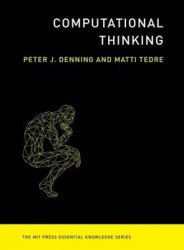 Название: Computational Thinking (The MIT Press Essential Knowledge series)
Название: Computational Thinking (The MIT Press Essential Knowledge series) Автор: Peter J. Denning, Matti Tedre
Издательство: MIT Press
Год: 2019
Страниц: 264
Язык: английский
Формат: pdf (conv), rtf, epub
Размер: 10.1 MB
A computer revolution is truly upon us. How shall we think about all this? What do we need to understand about computers? What must we do to put a computer to work for us? How do computers shape the way we see the world? What is the role of programming? Computational thinking (here abbreviated CT) offers some answers to these questions. Much of CT is specifically oriented on figuring out how to get a computer to do a job for us - how to control a complex electronic device to do a job reliably without causing damage or harm. Algorithms are the procedures that specify how the computer should do a job. Although humans can carry out algorithms, they cannot do so nearly as fast as a machine; modern computers can do a trillion steps in the time it takes a human to do one step. The magic is nothing more than a machine executing large numbers of very simple computations very fast. Programs are the bridge: algorithms encoded in special-purpose languages that translate to machine instructions that control a computer.
But CT reaches further than automation. Information and computational processes have become a way of understanding natural and social phenomena. Much of CT today is oriented toward learning how the world works.
Computational thinking has become a buzzword with a multitude of definitions. We have distilled the spirit of the multitude into this definition used throughout this book: Computational thinking is the mental skills and practices for
- designing computations that get computers to do jobs for us, and
- explaining and interpreting the world as a complex of information processes.
The design aspect reflects the engineering tradition of computing in which people build methods and machines to help other people. The explanation aspect reflects the science tradition of computing in which people seek to understand how computation works and how it shows up in the world.
There is clearly a special thinking skill required to successfully design programs and machines capable of enormous computations and to understand natural information processes through computation. This skill—computational thinking, or CT - is not a set of concepts for programming. Instead, CT comprises ways of thinking and practicing that are sharpened and honed through practice. CT is a very rich skill set: we outline the six dimensions of computational thinking that you will encounter in this book: machines, methods, computing education, software engineering, design, and computational science.
Software developers, having become aware of such a wide gap between basic programming and production systems, had to find new practices of CT to close it. They developed a trove of new forms of CT: new practices for decomposition, complexity, information structures, causality, closing semantic gaps, data abstraction, data structures, encapsulation, information hiding, recursion, project management, and software life cycles. Aspects of theoretical computer science, notably complexity theory and automatic theorem proving, became helpful in this arena.
Contents:
Скачать Computational Thinking (The MIT Press Essential Knowledge series)
